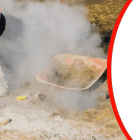Every day thousands of Australians get into the job of improving and maintaining their biggest investment: their home.
Many are unaware, however, of the silent killer that poses a serious threat to their health. This hazardous material, known as asbestos, is present in various home products and building materials—from water drainage, flue pipes, roofing shingles, and guttering, to vinyl floor coverings and fibro sheeting.
The Importance of Asbestos Inspection, Testing, and Management Plan
Most Australian homes built during the 1940s to 1980s contain some form of asbestos material or product. So if your property was constructed during this period, it is likely that your home has asbestos-containing materials (ACM). Hence, before doing any renovation on your property, take appropriate steps to protect yourself and your family from the potential dangers of asbestos exposure.Have a good asbestos management plan to safely remove, transport, or dispose of these hazardous elements away from your home. Also, learn these essential dos and don’ts in case a suspected asbestos-containing material is present in your property.
Dos
- Undertake an asbestos inspection by a NATA-accredited company to identify asbestos-containing materials and assess any damage that may present a risk of exposure.
- Keep your activities at a minimum so as not to disturb the damaged areas (e.g. walls and floors) until a maintenance service provider has repaired them.
- Hire a qualified removalist if you are planning to dispose of the suspected ACM.
Don’ts
- Undertake any home renovation work that involves drilling, water blasting, sawing, sanding, or grinding.
- Sweep, vacuum, dust, or clean surfaces or areas near the suspected asbestos-containing material.
- Remove vinyl tile floor coverings or sheeting and ceiling finishes.
- Use abrasive brushes to remove wax from the asbestos floor tile.
Because it’s hard to detect the presence of asbestos by just looking at the materials, the best way to be certain is to conduct an inspection and have the samples analyzed by a testing laboratory.
Only asbestos testing laboratories accredited by the National Association of Testing Authorities (NATA) can confirm the presence of this fibrous silicate mineral in your home. Thus, before undertaking any general home maintenance or renovation, get a confirmation from the testing company to ensure that your property is free from this hazardous material.
At Asbestos Check, we can help you identify, assess and control asbestos-related health risks. Our qualified consultants can conduct thorough asbestos inspection and testing in your home to identify possible ACM sources. We can also provide you with a specialized management plan to avoid getting exposed to this silent killer.







